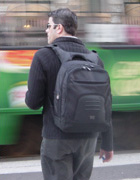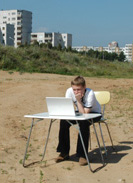"Electronic and electroacoustic music artists situated on the borders of serious contemporary music and other avant-garde currents" – is how the organizers of this year's Turning Sounds 3, an international conference in Warsaw for composers, DJs, performers, producers, as well as music critics and theorists defined one of its concerts on Sept. 24, which featured, among others, two Lithuanian representatives – Antanas Jasenka and Artūras Bumšteinas. Turned into a special 'satellite' of Warsaw Autumn this year, Turning Sounds 3 attempted to engage a new audience for avant-garde music, in particular one that often feels embarrassed by traditional concert situations, and to concentrate more on urban soundscapes, sound installations, spatial music and field recordings.
The abovementioned reference, and the concept of the entire event fairly accurately reflect the creative specificity and context of the work of Antanas Jasenka and Artūras Bumšteinas. Their music finds itself precisely in this transitional area – between contemporary academic music with its formal spaces and requisites, and the independent scene of experimental electronic music; between various tendencies germinating in the context of digital audiovisual arts. Such nomadic position is perhaps one of the motivators for their joint projects, the most memorable of which are works developing their audiovisual strategies.
One of their first collaborations was an audiovisual performance E-sutartinės (2003), with music by Jasenka and visuals by G-Lab, a creative alliance of Bumšteinas and Laura Garbštienė. E-sutartinės was first performed at the MaerzMusik festival in Berlin, later in its various forms at other international festivals, and as an electronic music piece over the radio in various countries around the world. E-sutartinės is not only a manifestation of a new audiovisual aesthetics, pulsating to the rhythm of a sound collage and visual dynamics, but also an audiovisual narrative based on the relationship between sound and image. The sutartinės, which intertwine to create a multi-layered vocal fabric, are gradually buried in an intense vortex of synthetic sounds; the visual fragments of Jasenka's self-portrait become a tool for its own deconstruction through montage and visual manipulation. Clearly visible alongside the engaging sound conveyer in this audiovisual performance is a motif typical of Antanas Jasenka, i.e., the relationship between man and machine, as developed in his other projects including Deusexmachina (2001), Boarding Pass (2004/2005) and Sonic Machine (2005).
An audiovisual narrative strategy figures in another G-Lab and Jasenka's piece called Invasion. Here it is expressed by less abstract means – including with the aid of story line which analyses various subjects and their imbedded confrontations: historical and individual time, sociological types and images, cinematic clichés and real events, observer-participant contradictions. The video unfolds in an atmosphere of lingering time, into which it is immersed by Jasenka's emotionally gripping music.
Jasenka and Bumšteinas have also collaborated on projects that explore the principles of collective mixing: No Video – No Noise, Audio Shrift, massON, Chaos?, Life After the Earthquake, and Experimental Sound Mixer. Most of these works leap fairly radically into the space of electronic improvisation, post-noise aesthetics, and sound relationships that are shaped in real time and are therefore difficult to predict. The mixthemixthemix project, presented at this year's Jauna Muzika festival, carried out this concept through a multi-layer mix structure. In it several sound artists remix, live, the material from Antanas Kučinskas' Loop Catalogue, which in its turn employ sound excerpts from the work of other composers.
 |
A 'laptop orchestra' comes into play as a musical and in a certain sense scenic outfit in Jasenka's Boarding Pass – a composition for eight laptops and video which premiered at Jauna Muzika 2004. The electronic 'score' made up of prerecorded synthetic sounds is performed by eight sound artists and composers. In Boarding Pass, Jasenka leaps into a sphere which Roland Barthes would call "jetman mythology".
The extension of Boarding Pass is a DVD to be released in 2006 as the product of collaboration between sound artists re-mixing the original Boarding Pass material, and video artist Džiugas Katinas. Before its DVD release, the piece was shown at the Regional Settings film and video festival in Pärnu in October.
It is difficult to define the aesthetics of Jasenka's and Bumšteinas' electronic music in terms of a single style because its implementation depends on the individual projects. Since the mid-1990s the sound material in Jasenka's work has been based on a cut-off collage of different sound snippets combined with an academic electroacoustic tradition. The first such compositions – Room Music (1996) and Cut-off (1997) – were immediately noted by international recording companies specializing in experimental music. The 5 CD collection "RLW Tulpas, Selektion" (Staalplaat, 1997) included Room Music among the works of experimental electronic music figures like Jim O'Rourke, Achim Wollscheid, Toshiya Tsunoda, John Duncan and Ryoji Ikeda, among others. The culmination of this period, Deusexmachina, released by the Russian recording company Electroshock Records, received the 2002 Lithuanian Composers' Union award for the year's best electroacoustic work.
Jasenka moves from slow melancholy passages to futuristic bleeping cosmic engine rooms, all the while dabbling in avant-garde ambient and noise constructions. ... Excellent spacey sounds, some ambient and many quite harsh, make for a menacing sci fi soundtrack and sometimes fast action upside-down video game chaos.
Jerry Kranitz, Aural Innovations
His recent works, however, are influenced more by the new post-noise and post-techno trends in electronic music.
|

photo: Mirjam Wirz
|
Collective re-mixes inspired by Bumšteinas, noted for their 'massive attack' of sounds and their consciously chaotic structure, are also only one of his creative strategies. This Uniform (2005, released by the netlabel Conv, Spain) could be called new electronic minimalism; Anti-Radical Opera (2001-2005) and Retorta (2003) are steeped in a rarefied electroacoustic atmosphere which reveals the influence of the 20th century classics, e.g., the work of Morton Feldman. Upcoming Bumšteinas and G-Lab plans include participation in a Wilna 1914-style wedding party installation by Max Reinhardt, DJ, composer and theatrical inventor at Modern Art Oxford on Oct. 8, also featuring jazz and klezmer musicians Arkady Gotesman, Eugenijus Kanevičius, Liudas Mockūnas, Galina Liebensteyn and Boris Kirzner from Lithuania, and Vanya Krawczyk from the UK. G-Lab will also appear at the Sensoralia / RomaEuropa festival in Rome on Nov. 27, where their deep muted sounds will meet up with the eclectic DJ-ing of the UK's Wire Sound System in the foyer of the Sinopoli Hall.
© Tautvydas Bajarkevičius
Lithuanian Music Link No. 11
For more information, check websites:
http://www.mixthemixthemix.com/
www.bumstein.com/art


